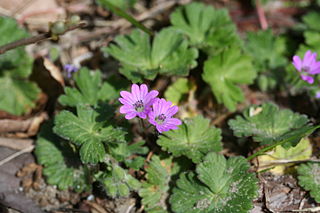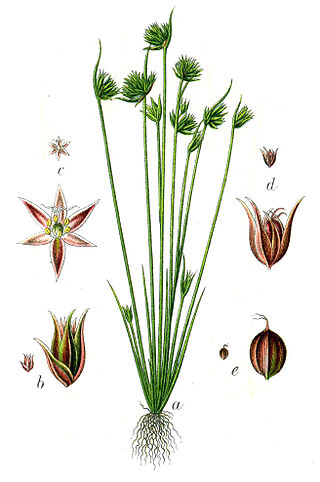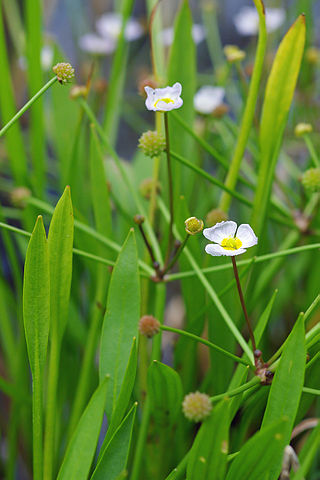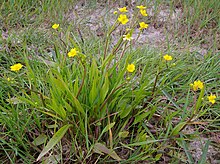
Nartheciaceae is a family of flowering plants. The APG III system places it in the order Dioscoreales, in the clade monocots. As circumscribed by APG IV (2016) it includes 35 species of herbaceous plants in the following five genera:

Narthecium ossifragum, commonly known as bog asphodel, Lancashire asphodel or bastard asphodel, is a species of flowering plant in the family Nartheciaceae. It is native to Western Europe, found on wet, boggy moorlands up to about 1,000 m (3,300 ft) in elevation. It produces spikes of bright yellow flowers in summer. The bright orange fruits have been used as a colourant to replace saffron by Shetland Islanders. Despite the plant's English name "bog asphodel", it is not particularly closely related to the true asphodels. In addition to other forms of pollination, this plant is adapted to rain-pollination. The Latin specific name ossifragum means "bone-breaker", and refers to a traditional belief that eating the plant caused sheep to develop brittle bones. The probable origin of this story is that sheep eating a calcium-poor diet are likely to develop bone weakness, and N. ossifragum favours acidic low-calcium soils.

Scheuchzeria palustris, is a flowering plant in the family Scheuchzeriaceae, in which there is only one species and Scheuchzeria is the only genus. In the APG II system it is placed in the order Alismatales of the monocots.

Rosa chinensis, known commonly as the China rose, Chinese rose, or Bengal rose, is a member of the genus Rosa native to Southwest China in Guizhou, Hubei, and Sichuan Provinces. The first publication of Rosa chinensis was in 1768 by Nikolaus Joseph von Jacquin in Observationum Botanicarum, 3, p. 7 & plate 55.

Arabis hirsuta, known as hairy rock-cress, is a flowering plant in the family Brassicaceae. In previous North American works, this species has been broadly defined to include plants native to Europe, Asia, and the northern half of North America, but is now more often restricted to a narrower subgroup restricted to Europe.

Geranium molle, the dove's-foot crane's-bill or dovesfoot geranium, is an annual herbaceous plant of the family Geraniaceae.

Juncus capitatus is a species of rush known by the common names dwarf rush and leafybract dwarf rush. It is native to Europe, Asia and North Africa. It is also an introduced species in parts of North America such as California and the Gulf Coast. It grows in moist areas, such as wet sand, vernal pools, and ditches.

Crepis paludosa, the marsh hawk's-beard, is a European species of flowering plant in the tribe Cichorieae of the family Asteraceae. It is widespread across much of Europe with isolated populations in Iceland, the Ural Mountains, and the Caucasus.

Schoenoplectus pungens is a species of flowering plant in the sedge family known as common threesquare, common three-square bulrush and sharp club-rush. It is a herbaceous emergent plant that is widespread across much of North and South America as well as Europe, New Zealand and Australia.

Ranunculus pusillus, commonly called low spearwort, is a species of flowering plant in the buttercup family (Ranunculaceae). It is native to much of the eastern United States from New York to Florida and west to Texas; it is also known in California. It grows in wet habitat, where it is semi-aquatic growing partially submerged or terrestrially on muddy substrates.

Lactuca perennis, common names: mountain lettuce, blue lettuce or perennial lettuce, is a perennial herbaceous plant species belonging to the genus Lactuca of the family Asteraceae. It is widespread across most of central and southern Europe. Its leaves are edible.

Ranunculus auricomus, known as goldilocks buttercup or Greenland buttercup, is a perennial species of buttercup native to Eurasia. It is a calcicole typically found in moist woods and at the margins of woods. It is apomictic, and several hundred agamospecies have been recognised.

Pimpinella major, common name greater burnet-saxifrage or hollowstem burnet saxifrage, is a herbaceous perennial plant in the genus Pimpinella belonging to the carrot family (Apiaceae).

Stachys recta, commonly known as stiff hedgenettle or perennial yellow-woundwort, is herbaceous perennial plant of the family Lamiaceae.

Leopoldia comosa is a perennial bulbous flowering plant in the family Asparagaceae. Usually called the tassel hyacinth or tassel grape hyacinth, it is one of a number of species and genera also known as grape hyacinths. It is found in rocky ground and cultivated areas, such as cornfields and vineyards in the Mediterranean region, but has naturalized elsewhere. In southern Italy and Greece, its bulb is a culinary delicacy.

Ranunculus pedatifidus is a species of buttercup known by the common names surefoot buttercup, northern buttercup, and birdfoot buttercup. It has a circumpolar distribution, occurring throughout the northern latitudes of the Northern Hemisphere. There are two varieties, var. pedatifidus occurring mostly in Asia and var. affinis mostly native to North America.

Pilularia globulifera, or pillwort, is an unusual species of fern in the family Marsileaceae. It is native to western Europe, where it grows at the edges of lakes, ponds, ditches and marshes, on wet clay or clay-sand soil, sometimes in water up to 30 cm (12 in) deep.

Baldellia ranunculoides, the lesser water-plantain, is a species of flowering plant in the family Alismataceae.

Allium carinatum, the keeled garlic or witch's garlic, is a bulbous perennial flowering plant in the family Amaryllidaceae. It is widespread across central and southern Europe, with some populations in Asiatic Turkey. It is cultivated in many places as an ornamental and also for its potently aromatic bulbs used as a food flavoring.



























